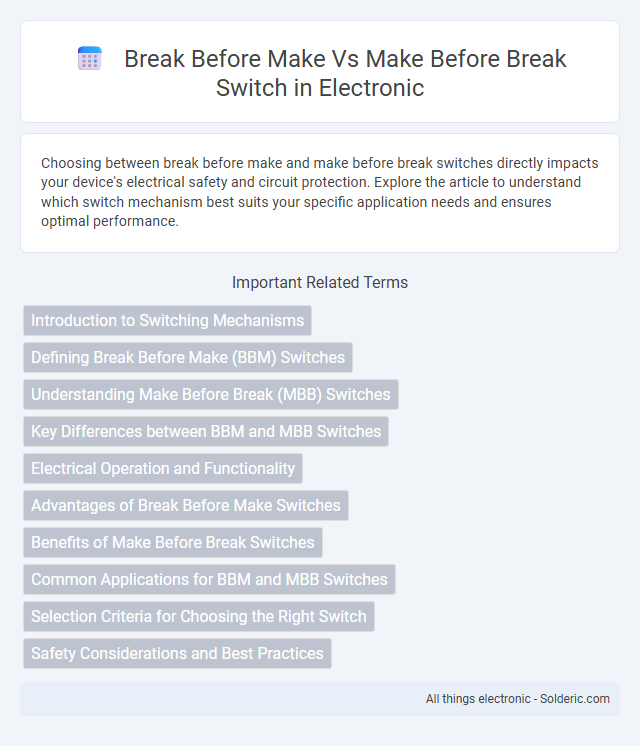Choosing between break before make and make before break switches directly impacts your device's electrical safety and circuit protection. Explore the article to understand which switch mechanism best suits your specific application needs and ensures optimal performance.
Comparison Table
| Feature | Break Before Make Switch | Make Before Break Switch |
|---|---|---|
| Switching Sequence | Disconnects the current connection before making a new one | Establishes the new connection before disconnecting the current one |
| Contact Overlap | No overlap; open circuit momentarily during switching | Contacts overlap; no open circuit during switching |
| Application | Used where isolation is critical to avoid short circuits | Used where continuous connection is needed to avoid signal loss |
| Risk of Short Circuit | Low risk due to open circuit before making new connection | Higher risk as two contacts may momentarily connect simultaneously |
| Common in | Single-pole, single-throw (SPST) switches, simple switching tasks | Multi-throw switches, audio/video switching, signal routing |
Introduction to Switching Mechanisms
Break before make switches interrupt the current circuit before establishing a new connection, preventing short circuits and ensuring device safety in electrical systems. Make before break switches maintain the existing connection until the new one is established, allowing seamless transitions, commonly used in audio and signal routing applications to avoid signal loss. These switching mechanisms are critical in designing reliable and efficient circuits, with their choice impacting operational stability and protection.
Defining Break Before Make (BBM) Switches
Break Before Make (BBM) switches are designed to open the current circuit connection before establishing a new one, preventing simultaneous contact and reducing the risk of short circuits or signal interference. This feature is critical in applications requiring safe transition between electrical states, such as in audio equipment and communication devices. BBM switches ensure clear, uninterrupted switching by prioritizing circuit disconnection before closure.
Understanding Make Before Break (MBB) Switches
Make Before Break (MBB) switches ensure continuity by connecting the new circuit before disconnecting the old one, preventing interruptions in signals or power flow. These switches are essential in applications requiring seamless transitions, such as audio equipment, telecommunications, and precision instrumentation. Understanding the contact arrangement and timing in MBB switches is crucial for selecting the right component to maintain circuit integrity and avoid transient disruptions.
Key Differences between BBM and MBB Switches
Break before make (BBM) switches ensure the current circuit is interrupted before a new circuit closes, preventing short circuits and signal overlap. Make before break (MBB) switches establish the new connection before disconnecting the previous one, allowing seamless transitions without loss of signal or power. Understanding these key differences helps you select the appropriate switch type for applications requiring either safety or continuity.
Electrical Operation and Functionality
Break before make switches interrupt the current in the first circuit before establishing a connection in the second, preventing short circuits and ensuring safe electrical operation. Make before break switches connect the second circuit before disconnecting the first, allowing continuous current flow and minimizing signal interruption during switching. Understanding your application's requirements is essential to choosing between these switch types for optimal electrical functionality.
Advantages of Break Before Make Switches
Break before make switches ensure the existing circuit opens completely before the new connection forms, preventing short circuits and electrical faults. This design enhances safety and reliability in sensitive electronic applications by eliminating accidental contacts and reducing electrical noise. Your systems benefit from minimized wear on contacts, leading to longer switch lifespan and improved performance.
Benefits of Make Before Break Switches
Make before break switches ensure continuous electrical connection by establishing a new contact before breaking the old one, minimizing power interruption and reducing arcing risk. This switching mechanism is crucial in applications requiring seamless transitions, such as audio signal routing and communication systems, where uninterrupted signal flow is essential. Their design enhances system reliability and prevents potential damage caused by momentary disconnections.
Common Applications for BBM and MBB Switches
Break Before Make (BBM) switches are commonly used in applications where it is critical to avoid short circuits during transition, such as audio switching and signal routing in telecommunications. Make Before Break (MBB) switches find frequent use in situations requiring continuous connection without interruption, like audio mixers and some instrumentation systems. Your choice between BBM and MBB switches depends on whether maintaining signal integrity during switch-over or preventing crossover shorts is more important in your application.
Selection Criteria for Choosing the Right Switch
When selecting between break before make and make before break switches, consider your application's requirements for contact continuity and safety. Break before make switches prevent simultaneous connection of two circuits, ideal for avoiding short circuits in sensitive electronics, while make before break switches ensure continuous connection, crucial for seamless signal transfer in audio or communication systems. Your choice depends on whether interrupting current flow or maintaining uninterrupted connectivity is the priority for your device's performance and reliability.
Safety Considerations and Best Practices
Break before make switches ensure the circuit opens before a new connection is established, minimizing the risk of short circuits and electrical arcing, which is crucial for operator safety and equipment protection. Make before break switches briefly connect the new circuit before disconnecting the old, which can cause unintended current flow and potential damage unless carefully managed with proper load ratings and insulation. Best practices involve selecting break before make designs for high-voltage or sensitive applications, while make before break switches are preferred in signal switching or where continuity is essential, always following manufacturer guidelines and incorporating proper safety interlocks.
Break before make vs Make before break switch Infographic

 solderic.com
solderic.com